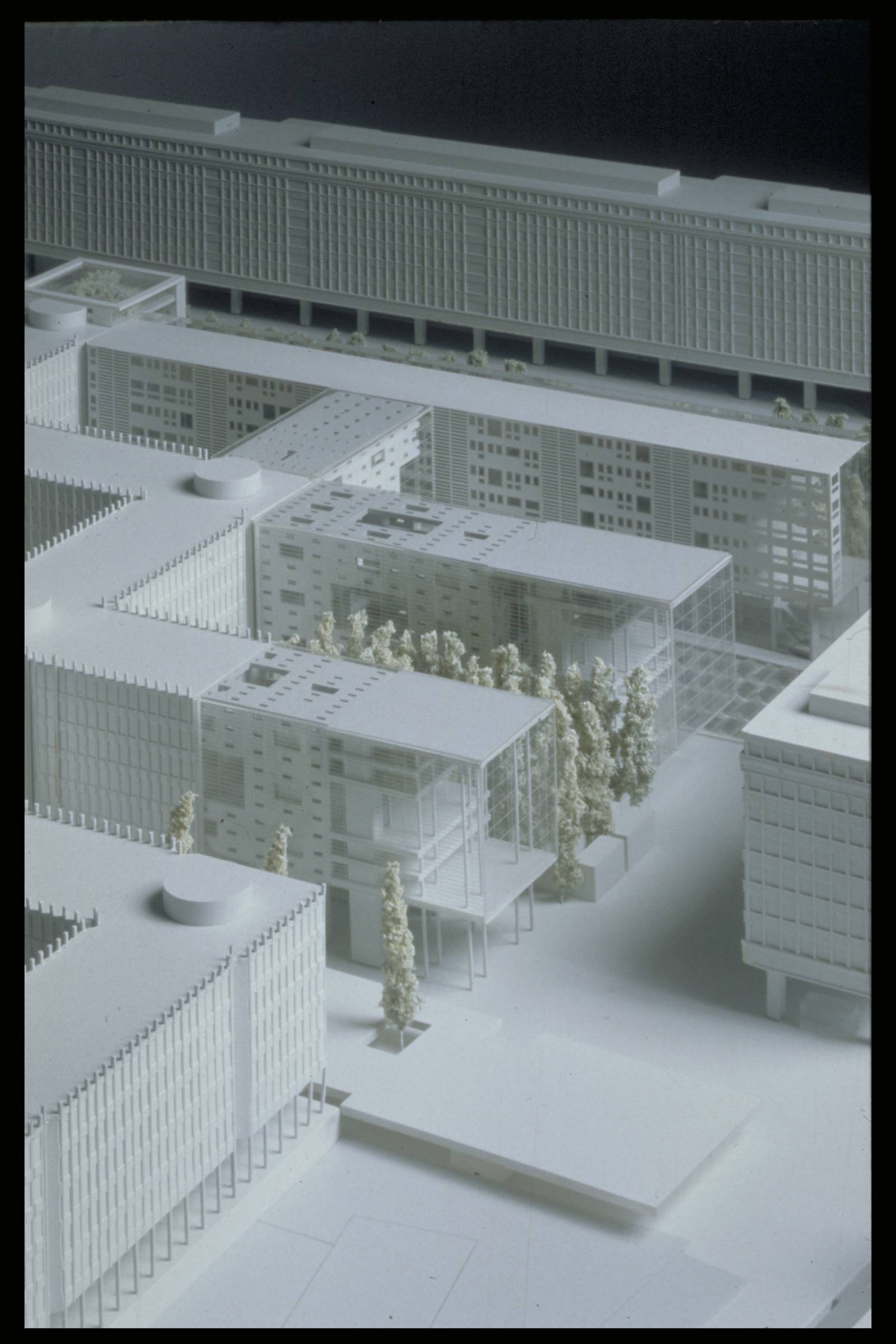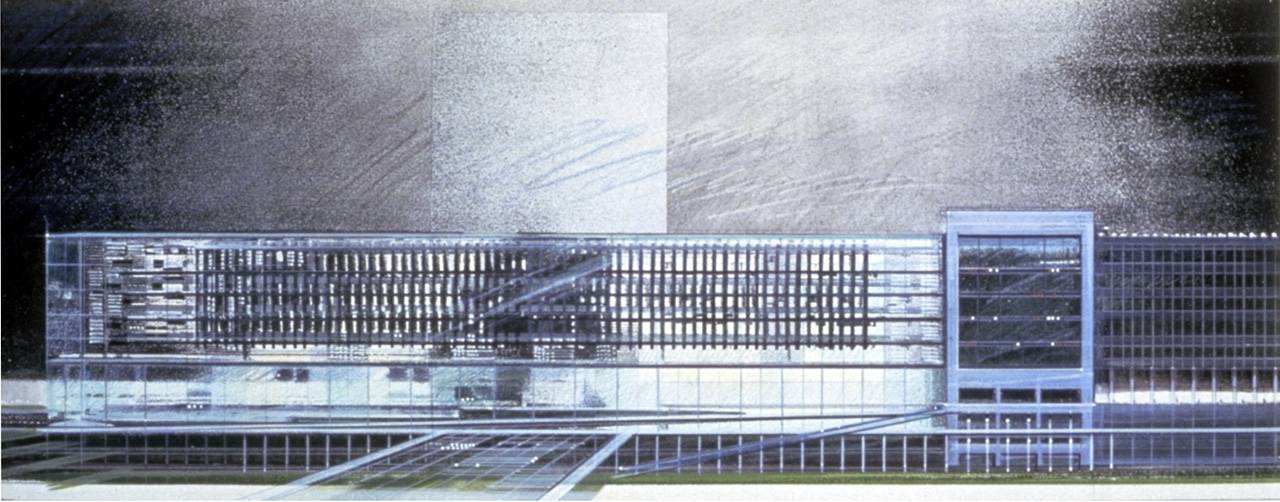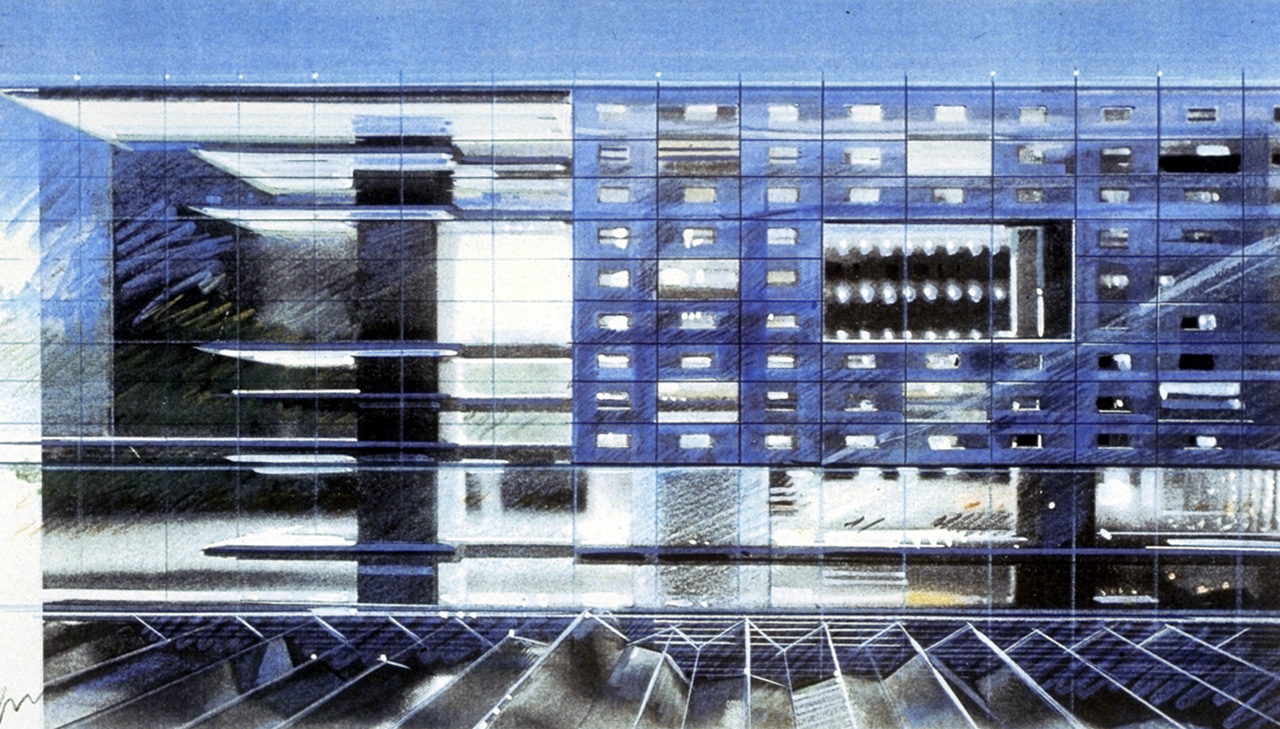- Previous project: Konrad-Adenauer Airport, Cologne/Bonn
- Next project: Jussieu Campus – ‘The Aircraft Carrier’
Jussieu University – Library
- Paris, France
Emptiness is a Virtue
‘I hate all movement that shifts lines…’
Charles Baudelaire
Albert’s architecture is hard to live with. But it has many fine qualities, including vigour and precision; it’s also relentlessly elegant and almost metaphysical in character thanks to the repetitiveness of the landscape. It’s like a musical scale: only the notes count.
The drawback with Albert’s music is that it needs to be reinvented over time. But in that regard, like the poet, ‘I hate all movement that shifts lines’, convinced as I now am that nothing good can come of spoiling the shape of the support; that no additional creation, nearby, that isn’t connected to the ‘Albertian’ system, is likely to solve the overall problem. As for existing alongside Albert, in spite of Albert, using him as a foil – that would only mean solving your own equation without providing an answer to the question as a whole.
The paradox of the situation lies in the fact that what’s required is simultaneously to set up complementary programs and to desaturate the place. Or, as the refrain goes, ‘Give us, give us oxygen, oxyyyygen!’– in other words, uncluttered space to breathe in, emptiness to suck into our lungs, light, trees, lawns, depth of field, vanishing points, through routes, gaps.
Here, emptiness becomes a virtue.
A dynamic is set up between Albert’s excess and the two adjacent tower blocks on the northern and eastern boundaries of the terrain.
The perspective from the opening at the boulevard Saint Germain is vital: it needs to be deep and clear, well-ordered and free of any hint of irrelevant prowess. It would be so tempting to do your number there – and so easy, with a bit of self-regarding myopia. The IMA (Institut du Monde Arabe) opens the door. The square slightly below it opens onto the university grounds.
What I propose, then, is to follow Albert’s lines – faithfully, rigorously – and to largely empty out the rest. The unevenness of the grounds makes it possible to have new buildings that are invisible and that open onto a double inner space bordered by a peristyle. This will be a green space, evenly lined with plants; a sunny, clearly demarcated space, flowing on from the cafeteria-restaurant and from some of the teaching rooms, too…
It will be an urban square overlooked by the walkways that wind round it.
The elevated slab base of Albert’s buildings will thereby be rewritten. With gaps that open onto various facilities, which will be lit up and multicoloured, like the new facilities located up against the slab and enjoying a view over the new square.
The gable walls provide the right location to set up screen-buildings, which, like the new facilities, will also frame the life of the faculty.
The tower blocks will be cleared at ground level of the hasty enclosures that housed sports facilities and a library as an emergency measure. What we want, in short, is empty space, and more empty space so that, from the quay, pedestrians and motorists alike can see the university square and, from the Jardin des Plantes, visitors can make out the extension.
The libraries will be set up as a superstructure over Albert’s lines. The light will come in from inside via a host of lustres, reminiscent of those ‘large eyes with their everlasting fire’, ‘pure mirrors that make all loveliness higher’ our poet talks about.
The façades, which will be fully glazed on the northern and eastern sides, will make the envelope virtual. The lines will become thin, indistinct. With the sun, the backlighting will do the rest. With the dark, the interior will itself become a façade in a masterly interplay of the hidden and the revealed, but this interplay will be ratcheted up with the interior fit-outs… Blacks, whites – notes on the lines, every time.
The esthetic systems will overlap. The libraries will be reflected over the stippled rooftops of the ‘greenhouses’ covering the gyms. And the green of the leaves will slip in beneath the glass… The extended slab will turn into a garden beneath the trees, for children; then there’ll be a walkway ramp over the exhibitions and the bookshop. Green will also slip in under the awning that hangs over the metro entrance and shelters the square below.
At each end of the square, two large ‘staircases’ consisting of wide terraces lined with plants will accommodate an extension of the IMA and a library. On one side, the plants will be the same clipped shrubs featured in the forecourt, thereby symbolising association with the Institut. On the other side, standard trees in micro-patios will shade readers in the library. So, we’ll have two uneven levels of greenery reminiscent of an Italian garden that’s been stretched out across the space…
This vacuum development will be complemented by the architecture already proposed for the two tower blocks which involves broad terraces overlooking Paris and the Jardin des Plantes, wide corridors leading to the Quai Tino Rossi… And, as a full-stop (?), the refurbishment or drastic alteration of the Tour Zamansky so that this distant signal finally turns into the friendly church tower of this student town.
Jean Nouvel





